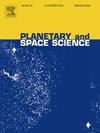实用的火星外部地球保护:来自犹他州火星沙漠研究站的经验教训
IF 1.7
4区 物理与天体物理
Q3 ASTRONOMY & ASTROPHYSICS
引用次数: 0
摘要
在我们太阳系的行星中,火星可能是最有可能找到生命证据和了解行星进化的地方。然而,在探索火星的过程中,由于缺乏法律框架或实际指导方针,我们可能会破坏可能具有突出普遍地质遗产价值的遗址。本研究旨在开发实用的外部地球保护方法,并在火星沙漠研究站(MDRS)进行为期一个月的两次机组轮换试验。然而,在任务前规划和现场勘探中都存在一些意想不到的挑战,这使得有效、实用的外部地球保护变得非常具有挑战性。这项模拟研究对继续进行火星探索具有启示意义,因为如果没有实用的外部地球保护方法,我们可能会冒着破坏火星上可能具有突出普遍地质遗产价值的地点的风险。我们发现,火星的外部地球保护将需要比目前可用的更详细的信息和研究。这项研究的一个关键含义是,对潜在重要露头的采样应该保留到整个地区进行深入探索之后,以确保所采集的样本既特殊又常见,足以允许将其移除。我们还发现,火星探险队的地球保护专家在将外部地球保护原则带到火星任务的前沿方面发挥着重要作用。本文章由计算机程序翻译,如有差异,请以英文原文为准。
Practical exogeoconservation of Mars: Lessons from the Mars Desert Research Station, Utah
Of the planets in our solar system, Mars may be the most likely place to find evidence of life and learn about planetary evolution. However, in exploring Mars, we risk damaging sites of possible outstanding universal geoheritage value due to a lack of legal frameworks or practical guidelines. This study sought to develop practical exogeoconservation methods and test these at the Mars Desert Research Station (MDRS) over two crew rotations, totalling one month. However, there were several unanticipated challenges both in pre-mission planning and on-site, in-person exploration, making effective, practical exogeoconservation extremely challenging. This analogue study has implications for continued Mars exploration, as without practical exogeoconservation methods, we may risk the destruction of sites of possible outstanding universal geoheritage value on Mars. We find that exogeoconservation of Mars will require significantly more detailed information and study than is currently available. A key implication of this study is that sampling of potentially important outcrops should be reserved until after a whole area has been explored in-depth, to ensure the samples taken are both exceptional and common enough to allow for their removal. We also find that there is a role for geoconservation experts on Mars exploration teams to bring exogeoconservation principles to the forefront of Mars missions.
求助全文
通过发布文献求助,成功后即可免费获取论文全文。
去求助
来源期刊

Planetary and Space Science
地学天文-天文与天体物理
CiteScore
5.40
自引率
4.20%
发文量
126
审稿时长
15 weeks
期刊介绍:
Planetary and Space Science publishes original articles as well as short communications (letters). Ground-based and space-borne instrumentation and laboratory simulation of solar system processes are included. The following fields of planetary and solar system research are covered:
• Celestial mechanics, including dynamical evolution of the solar system, gravitational captures and resonances, relativistic effects, tracking and dynamics
• Cosmochemistry and origin, including all aspects of the formation and initial physical and chemical evolution of the solar system
• Terrestrial planets and satellites, including the physics of the interiors, geology and morphology of the surfaces, tectonics, mineralogy and dating
• Outer planets and satellites, including formation and evolution, remote sensing at all wavelengths and in situ measurements
• Planetary atmospheres, including formation and evolution, circulation and meteorology, boundary layers, remote sensing and laboratory simulation
• Planetary magnetospheres and ionospheres, including origin of magnetic fields, magnetospheric plasma and radiation belts, and their interaction with the sun, the solar wind and satellites
• Small bodies, dust and rings, including asteroids, comets and zodiacal light and their interaction with the solar radiation and the solar wind
• Exobiology, including origin of life, detection of planetary ecosystems and pre-biological phenomena in the solar system and laboratory simulations
• Extrasolar systems, including the detection and/or the detectability of exoplanets and planetary systems, their formation and evolution, the physical and chemical properties of the exoplanets
• History of planetary and space research
 求助内容:
求助内容: 应助结果提醒方式:
应助结果提醒方式:


